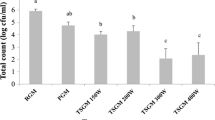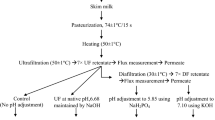Abstract
Recombined milk (RM) can be prepared by blending of butteroil, skim milk powder and water and used for variety of purposes in dairy industry. The present work was undertaken to investigate the feasibility of a custom designed and fabricated universal disperser unit for the preparation of recombined milk. Water, SMP and butteroil were used to manufacture the recombined milk. Three levels of fat viz 1.5%, 3.0% and 4.5% were evaluated to study the effect of fat content on the recombination efficiency of the universal disperser using a high shear saw tooth impeller to impart the required shear and disperse the fat in water–SMP matrix to form a stable emulsion. Two independent parameters i.e. temperature at three different levels (20, 35 and 50 °C) and impeller speed (10,000, 15,000 and 20,000 rpm) were selected for the study. All operations were carried out in heating cum process vessel having working capacity of 3 L. The efficiency of the operation was judged based on the dependent parameters namely, mixing time, mixing index, creaming index, power consumption and overall acceptability. Experiments were designed as per RSM in Design Expert V.10.0 software and results obtained were optimized and predicted solutions were compared with observed data. From the study, the optimal combinations for preparation of recombined milk were obtained as 1.5% Fat RM (17,820 rpm, 48 °C), 3.0% Fat RM (15,701 rpm, 48 °C) and 4.5% Fat RM (15,459 rpm, 48 °C).




Similar content being viewed by others
References
Adepoju TF (2014) Response surface methodology (RSM) a good optimizer for transesterification reaction of Chrysophyllum albidium seed oil to Chrysophyllum albidium oil biodiesel. Int J Chem Process Eng Res 1(4):32–42. https://doi.org/10.18488/journal.65/2014.1.4/65.4.32.42
Aken GA, Visser KA (2000) Firmness and crystallization of milk fat in relation to processing conditions. J Dairy Sci 83(9):1919–1932
Berk Z (2018) Mixing: In: Food process engineering and technology, 3rd edn. Academic press, pp 193–217
Cam M, Aaby K (2010) Optimization of extraction of apple pomace phenolics with water by response surface methodology. J Agric Food Chem 58:9103–9111. https://doi.org/10.1021/jf1015494
Ertugay MF, Şengul M, Şengul M (2004) Effect of ultrasound treatment on milk homogenisation and particle size distribution of fat. Turk J Vet Anim Sci 28(2):303–308
Hall S, Pacek AW, Kowalski AJ, Cooke M, Rothman D (2013) The effect of scale and interfacial tension on liquid–liquid dispersion in in-line Silverson rotor–stator mixers. Chem Eng Res Des 91(11):2156–2168
Huppertz T (2011) Homogenization of milk | other types of homogenizer (high-speed mixing, ultrasonics, microfluidizers, membrane emulsification). In: Fuquay JW (ed) Encyclopedia of dairy sciences, 2nd edn. Academic Press, London, pp 761–764. https://doi.org/10.1016/B978-0-12-374407-4.00226-0
IS: SP: 18 (1981) ISI handbook of food analysis, Part XI, Dairy products. Indian Standard Institution, Manak Bhavan, New Delhi, India
Jeantet R, Schuck P, Six T, Andre C, Delaplace G (2010) The influence of stirring speed, temperature and solid concentration on the rehydration time of micellar casein powder. Dairy Sci Technol 90:225–236
Kaladhar M, Subbaiah KV, Rao CS (2012) Machining of austenitic stainless steels: a review. Int J Mach Mach Mater 12(1–2):178–192
Kuakpetoon D, Flores RA, Milliken GA (2001) Dry mixing of wheat flours: effect of particle properties and blending ratio. LWT 34(3):183–193
Lacey PMC (1954) Developments in the theory of particle mixing. J Appl Chem 4(5):257–268
Li Y, Joyner HS, Carter BG, Drake MA (2018) Effects of fat content, pasteurization method, homogenization pressure, and storage time on the mechanical and sensory properties of bovine milk. J Dairy Sci 101(4):2941–2955
McCarthy KS, Lopetcharat K, Drake MA (2017) Milk fat threshold determination and the effect of milk fat content on consumer preference for fluid milk. J Dairy Sci 100(3):1702–1711
Oshinowo L, Bakker A, Marshall E (2000) Simulating mixing time with computational fluid dynamics. Fluent Software, JAIII:1-5. (cited from Gupta, D. (2003). Design and development of mixing and blending mechanism in conical process vat for viscous dairy products (M.Tech dissertation, NDRI, Karnal)
O’Sullivan JJ, Drapala KP, Kelly AL, O’Mahony JA (2018) The use of inline high-shear rotor–stator mixing for preparation of high-solids milk protein-stabilised oil-in-water emulsions with different protein: fat ratios. J Food Eng 222:218–225
Qiu LP, Zhao GL, Wu H, Jiang L, Li XF, Liu JJ (2010) Investigation of combined effects of independent variables on extraction of pectin from banana peel using response surface methodology. Carbohydr Polym 80(2):326–331
Rybak O (2016) Milk fat in structure formation of dairy products: a review. Ukrain Food J 5(3):499–514
Tetrapak (2015) White paper on new processing method for recombined white milk. http://www.tetrapak.com/processing/dairy/recombined-milk. Accessed on June 2019
Tong PS (2002) Liquid milk products: recombined and reconstituted products. In: Smithers G (ed) Reference module in food science, encyclopaedia of dairy sciences, 2nd edn. Elsevier, Amsterdam, pp 316–319
Veena N, Nath S, Naik L, Kumar S (2017) Sensory and physico-chemical properties and fatty acid profile of milk fortified with flaxseed oil. Indian J Dairy Sci 70(4):486–490
Walstra P (1999) Dairy technology: principles of milk properties and processes. CRC Press, London, pp 445–470
Zhang J, Xu S, Li W (2012) High shear mixers: a review of typical applications and studies on power draw, flow pattern, energy dissipation and transfer properties. Chem Eng Process 57:25–41
Author information
Authors and Affiliations
Corresponding author
Additional information
Publisher's Note
Springer Nature remains neutral with regard to jurisdictional claims in published maps and institutional affiliations.
Rights and permissions
About this article
Cite this article
Datir, R.P., Ravindra, M.R., Manjunatha, M. et al. Optimization of recombination of milk at different fat levels in a small volume universal disperser unit. J Food Sci Technol 58, 1389–1400 (2021). https://doi.org/10.1007/s13197-020-04650-9
Revised:
Accepted:
Published:
Issue Date:
DOI: https://doi.org/10.1007/s13197-020-04650-9




